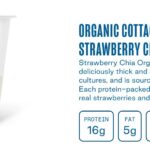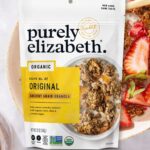Front-of-Package Food Labeling: A New Approach to Public Health
I have always believed that nutrition panels on the back of a package should be simplified to a red, yellow, or green image on the front of the box. Streamlining the message that a package is good, average, or bad for you could help consumers make decisions. Consumers could buy only green-label packages for themselves and their families and avoid red-labeled products.
In recent years, there has been growing support for front-of-package (FOP) food labeling legislation in the United States. Senator Bernie Sanders and other members of Congress have been advocating for more precise, more prominent nutritional information on food packaging. This initiative aims to help consumers make informed decisions about their food choices and address rising concerns about obesity and other health issues related to diet.

What is FOP – Front-of-Package Labeling?
FOP labeling typically involves placing simplified nutritional information on food packages, often using color-coded systems or easy-to-understand symbols. This approach is designed to provide consumers with at-a-glance information about the nutritional content of packaged foods, particularly regarding elements like sugar, salt, and fat.
Pros of FOP Labeling Legislation
1. Increased Consumer Awareness: FOP labels make nutritional information more accessible, potentially leading to better-informed food choices.
2. Simplified Information: Complex nutritional data is distilled into easy-to-understand formats, benefiting consumers who may not have the time or knowledge to interpret detailed nutrition labels.
3. Potential Health Benefits: FOP labeling could reduce obesity and related health issues by encouraging healthier food choices.
4. Industry Accountability: The legislation may motivate food manufacturers to improve the nutritional quality of their products to avoid negative labeling.
Cons of FOP Labeling Legislation
1. Implementation Costs: Food manufacturers may face significant expenses in redesigning packaging and potentially reformulating products.
2. Potential for Oversimplification: Some argue that reducing complex nutritional information to simple symbols might oversimplify nutrition science.
3. Consumer Confusion: Multiple labeling systems could lead to confusion if not standardized across all products.
4. Impact on Small Businesses: Smaller food producers might struggle with the costs and complexities of implementing new labeling systems.
Global Effectiveness
Several countries have implemented FOP labeling systems with varying degrees of success:
1. Chile: In 2016, the country introduced black warning labels on foods high in calories, saturated fats, sugar, and sodium. Early studies have shown decreased purchasing of unhealthy foods, particularly sugary drinks.
2. United Kingdom: The traffic light system (red, amber, green) has been in use since 2013. While voluntary, it has been widely adopted. Studies suggest it has led to some improvements in food choices, though the impact on obesity rates is less clear.

3. France: The Nutri-Score system, introduced in 2017, uses color coding and letter grades. Initial research indicates increased consumer awareness, but long-term health impacts are still being studied.
4. Mexico: In 2020, it implemented warning labels similar to Chile’s. Early data suggests a reduction in the purchase of products with warning labels, particularly among lower-income consumers.
While these examples show promising signs, it’s important to note that FOP labeling is just one tool in the complex fight against obesity and diet-related health issues. Its effectiveness often depends on its implementation alongside other public health measures.
A Step Forward

Front-of-package food labeling legislation represents a significant step towards empowering consumers with more explicit nutritional information. While it shows promise in influencing food choices and potentially improving public health, its implementation comes with challenges. As the debate continues in the U.S., policymakers will need to carefully consider the experiences of other countries and balance the potential benefits against the costs and complexities of implementation.
Ultimately, FOP labeling is not a silver bullet for solving obesity and related health issues, but it could be a valuable component of a comprehensive public health strategy. As more data becomes available from countries implementing these systems, we’ll understand their long-term effectiveness in promoting healthier eating habits and improving public health outcomes.
In recent years, there has been growing support for front-of-package (FOP) food labeling legislation in the United States. Senator Bernie Sanders and other members of Congress have been advocating for more precise, more prominent nutritional information on food packaging. This initiative aims to help consumers make informed decisions about their food choices and address rising concerns about obesity and other health issues related to diet.
What’s your opinion about FOP (front of package) labeling for food and beverage products in the U.S.?
Photo by Joshua Rawson-Harris on Unsplash
Images from: Center for Science in the Public Interest
Connect with Jeff at The Marketing Sage Consultancy. Interested in setting up a call with me? Use my calendly to schedule a time to talk. The call is free, and we can discuss your brand and marketing needs. If you want to learn more about my new offering, The Trusted Advisor Board, you can click here to learn the details. Feel free to email me at jeffslater@themarketing sage.com or text 919 720 0995. Thanks for your interest in working with The Marketing Sage Consultancy.





